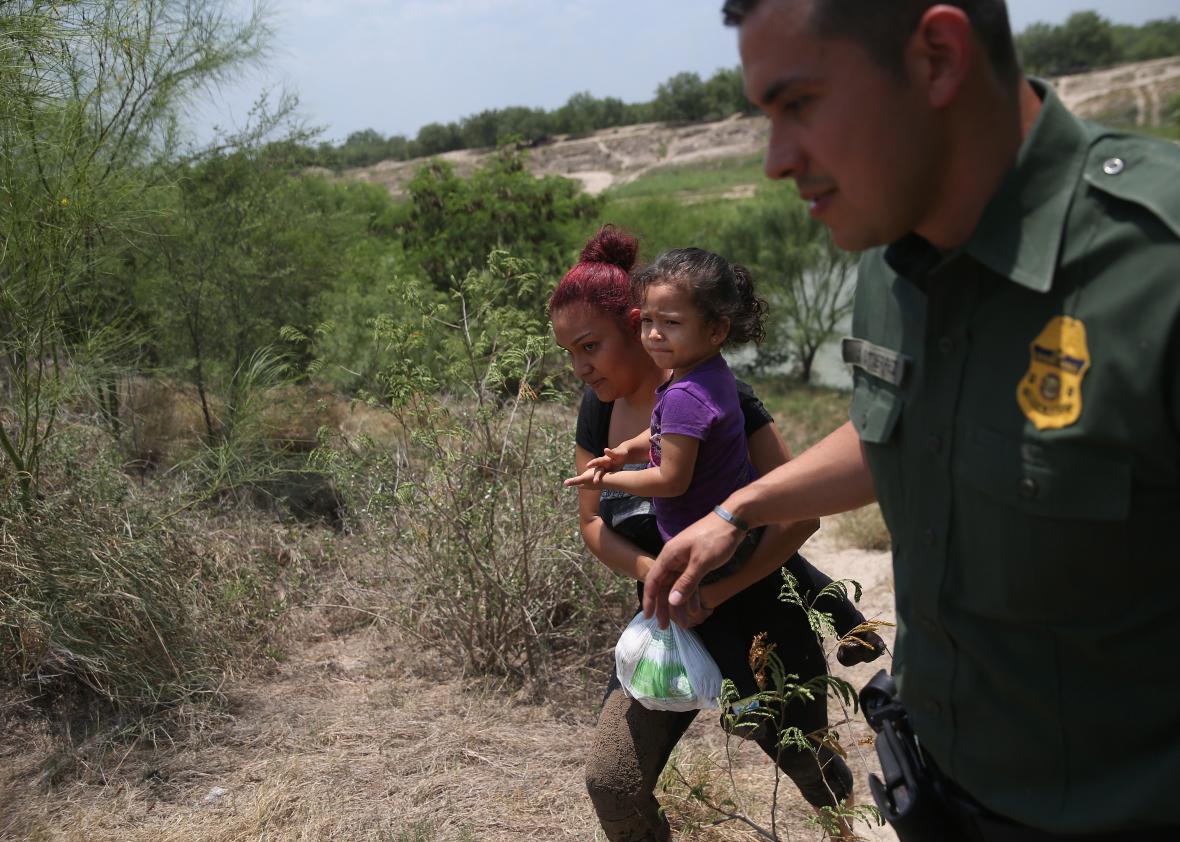The Trump administration is boasting of an immigration-policy success after the Department of Homeland Security reported a 93 percent decrease in parents apprehended with children trying to cross the U.S.-Mexico border. In December, border patrol agents apprehended 16,000 parents and children, Reuters reports. Immigration numbers usually increase in March, when the weather gets warmer, but this year, DHS recorded only a little more than 1,100 apprehensions of parents and children for the month. The drop was even more significant than the already-steep decrease in total apprehensions, which fell 72 percent from December to March.
In early March, Reuters reported that DHS was considering a policy that would separate mothers and their children if apprehended at the border, an unprecedented shift away from previous policies that allowed many people seeking asylum to live freely in the U.S. until their hearings instead of in detention centers. The proposed policy, which would detain mothers in detention facilities and send their children into protective custody with the Department of Health and Human Services, was floated as a way around a federal court ruling that prohibited long-term detention of minors. It was justified as a deterrent that would keep parents in fear of losing their children from making the journey to the U.S.
Now, it seems the policy was as effective as a threat as it might have been as a course of action. DHS never even had to implement the proposed policy to see a dramatic reduction in the fastest-growing segment of undocumented immigrants or asylees: parents crossing the border with children. There were other threatened policies, including one that would have allowed the U.S. to prosecute parents for human trafficking if they hired smugglers to get their children across the border safely. But parents have not been prosecuted, and mothers have not been detained while their children got sent to HHS facilities. Instead, thousands of parents were forced to choose between staying at home in potentially dire situations and risking rumored criminal charges or enforced separation from their children in the U.S.
Trump did make one recent concrete shift in his administration’s approach to asylum cases. In February, updated instructions for asylum officers directed them to be more skeptical of asylum applicants claiming “credible fear” of returning to the nation from which they fled. In 2016, asylum officers found about eight in 10 cases of claimed credible fear to be valid and moved those applicants forward in the asylum application process. Previously, asylum officers were instructed to move a case forward and let a judge make the final decision even if an officer had reasonable doubt about an applicant’s credible fear. The new documents don’t contain that instruction, and they go further to advise that a person’s awkward demeanor or caginess may be signs of untrustworthiness instead of the logical product of fear, trauma, or a language barrier.
Reuters claims that after it broke the news that DHS was considering separating mothers from children in March, “Democratic members of Congress blasted the proposal, and within days it had made headlines across Mexico and Central America. … The possibility that mothers and children might be separated at the border caused particular alarm.” Two-thirds fewer parents with children were apprehended at the border that month. Some were convinced to stay in their dangerous home circumstances by U.S.- and U.N.-funded public service announcements that aired in Central American countries, telling horror stories of journeys north and quoting parents who allegedly sent their kids to the U.S. for a better life, then never heard whether they made it there safely.
This makes it seem like the leak of the DHS proposal could have been intentional. As I wrote in March, the policy would have been largely unenforceable at current immigration rates. The U.S. government is not equipped to detain and take into protective custody the thousands of extra parents and children who would have otherwise been allowed to live independently while applying for asylum or waiting for immigration hearings. By leaking a harsh proposed policy instead of actually setting it in motion, DHS was able to strike fear into families without having to enforce a policy and deal with the poor human-rights optics it would have yielded.
Last month, an attorney at Oakland, California’s Centro Legal de la Raza told me the proposed DHS policy wouldn’t even work as a deterrent, because “People don’t leave their country and travel through multiple other countries, often really dangerous journeys, with their children just for kicks. People are fleeing because their lives are under threat.” She went on: “A lot of our clients, a lot of the stories we hear, are that people … get a threat and within that week, they’re gone. I don’t think people are looking into the details of border patrol policy at the moment when they make that difficult decision to leave their home.”
In statements about the steep decline in parents bringing children across the border, the DHS has made the opposite argument—that crueler policies promise to make migrating to the U.S. almost as punishing as the circumstances in refugees’ home nations. As a DHS spokesman told Reuters, the rumors of mistreatment they might receive at the U.S. border resulted in “15,000 women and children who did not put themselves at risk of death and assault from smugglers to make the trip north.” Thousands of these families still have credible fear of staying in their communities, which would make them eligible for asylum in the U.S. The only thing that’s changed is a newfound fear of what the U.S. might do to them once they get here.
